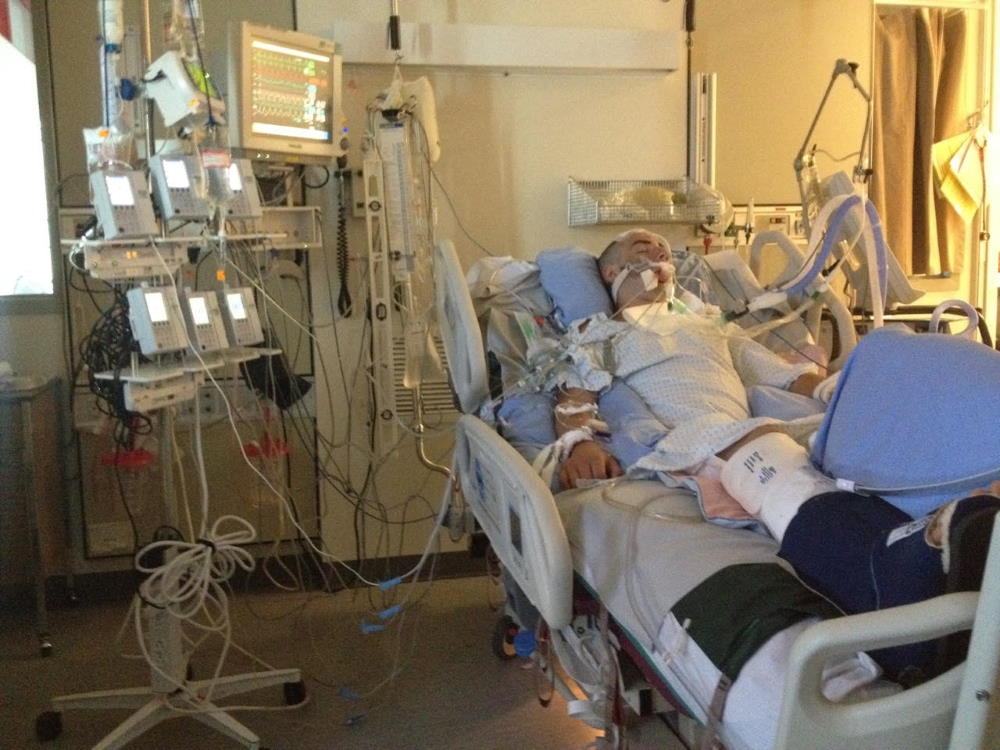When Mitch suffered a traumatic brain injury, his whole world changed. The rapid and accurate imaging and medical assessments he received in the Intensive Care Unit (ICU) at Victoria General Hospital (VGH) were critical for his recovery and quality of life.
In July of 2012, Mitch had just returned home to Tsawwassen after finishing his first year at the University of Calgary. He was hiking on Galiano Island while on a camping trip with 15 of his closest friends when the unstable ground on the edge of a cliff gave way. He fell close to 50 feet and, as a result, sustained numerous injuries. Of these injuries, most notable were a severe traumatic brain injury, a coma, and a depressed skull fracture.
After he was stabilized on the ground, Mitch was airlifted to the closest high-level trauma centre at VGH. There, he would spend the next month in the ICU and begin on his road to diagnosis, treatment, and recovery.
His time in the ICU was an uncertain one. “The care team told my parents I had suffered a serious accident, and I would likely live the rest of my life with significant physical and mental deficits if I did not succumb to my injuries. From what I was told, it truly is because of the quick intervention and world-class expertise of the Critical Care and Neurosurgery teams that I am here today,” shares Mitch.
His mom was able to take time off work to stay by his side every day, and his dad and brother visited often. Mitch credits their support as being instrumental in his healing process.

The CT scans Mitch received at VGH during the first week were instrumental in his care. Mitch’s care team, including intensivist Dr. Lorne Porayko, quickly got the CT images they needed to assess Mitch’s injuries. By interpreting these images of Mitch’s brain, his care team was able to see that he still had viable brain tissue. They also identified areas in his brain where bleeding and swelling could cause further damage that would need careful attention and further treatment.
“Mitch’s first CT scan showed that he had a subdural hematoma, or blood on top of the brain. His was not large enough to need surgery at that time. One third of similar hematomas get bigger and need intervention within 24 to 48 hours, so we monitored him closely with repeated CT scans and clinical exams to check for signs like dilated fixed pupils and weakness on one side of the body,” explains Dr. Porayko.
The CT scans also showed that Mitch had two contusions in his brain. Like bruises, these can swell aggressively over the following week and become life-threatening.
In those early days, the trauma to Mitch’s brain had caused swelling. A surgeon placed an external ventricular drain to manage the extra fluid that was causing the elevated intracranial pressure. Repeated CT scans revealed that the swelling was receding and helped prevent an additional risky and more invasive surgery that he didn’t need after all.
When you, our donors, fund advanced equipment like a CT scanner, it supports our experienced and skilled caregivers to deliver the best possible care to their patients. They can often detect changes in a patient’s condition, such as intracranial pressure, through medical imaging before clinical signs change.
“Advanced imaging like CT scans give us a window of opportunity to intervene and save lives,” Dr. Porayko says. “It is fundamental to the care we provide.”
Mitch says he doesn’t remember much from his time in the ICU. Once he regained consciousness after two weeks, he was unable to form new memories in the following weeks and only then slowly regained that ability.
The right side of Mitch’s brain suffered significant damage, impacting the motor functions on the left side of his body and his ability to use language. At first, he couldn’t walk and had very limited memory and speech. With time and hard work, Mitch has now regained most of these functions.
Though Mitch’s recovery was far from over when he left VGH a month after his accident, he says that the excellent care he received there set him on the right path. Having the knowledge of how his brain was impacted through the CT scans has helped Mitch tremendously. They shaped his ongoing treatment plan to focus his efforts on re-building the neural networks in the damaged areas.
After stubbornly returning, against medical advice, to the University of Calgary the following January, Mitch decided that being closer to home – and the hospital that saved his life – would be a better fit. He graduated with a Bachelor of Commerce from the University of Victoria in 2016, and has been living, working, and even occasionally hiking here ever since. “I am so grateful to have this rare opportunity to live through such an experience and be able to tell my story,” says Mitch.
Reflecting on his journey Mitch shared these powerful words:
“To the care teams in the ICU, I would like to say that without you, I would not be here today.
To donors, please know that equipment like the CT scanner made all the difference in my care. This new equipment being supported through The Big Picture can make that difference for so many more patients like me.”
Dr. Porayko can attest that every patient who needs intensive care requires medical imaging. For an acutely ill patient, CT imaging is often the best option because it is safe, non-invasive, and quick — and because it allows the care teams to go beneath the surface and understand what is happening inside a patient’s body. Caregivers can closely monitor the patient during the scan and get the detailed images that they need to make the best care decisions for their patients in a short amount of time.
It is advancements in medical imaging like CT scans that have dramatically improved outcomes for patients with severe traumatic brain injuries like Mitch.
That’s what The Big Picture is all about.
Donate here to contribute to The Big Picture campaign and to support the thousands of patients that need CT scans at our hospitals annually.




